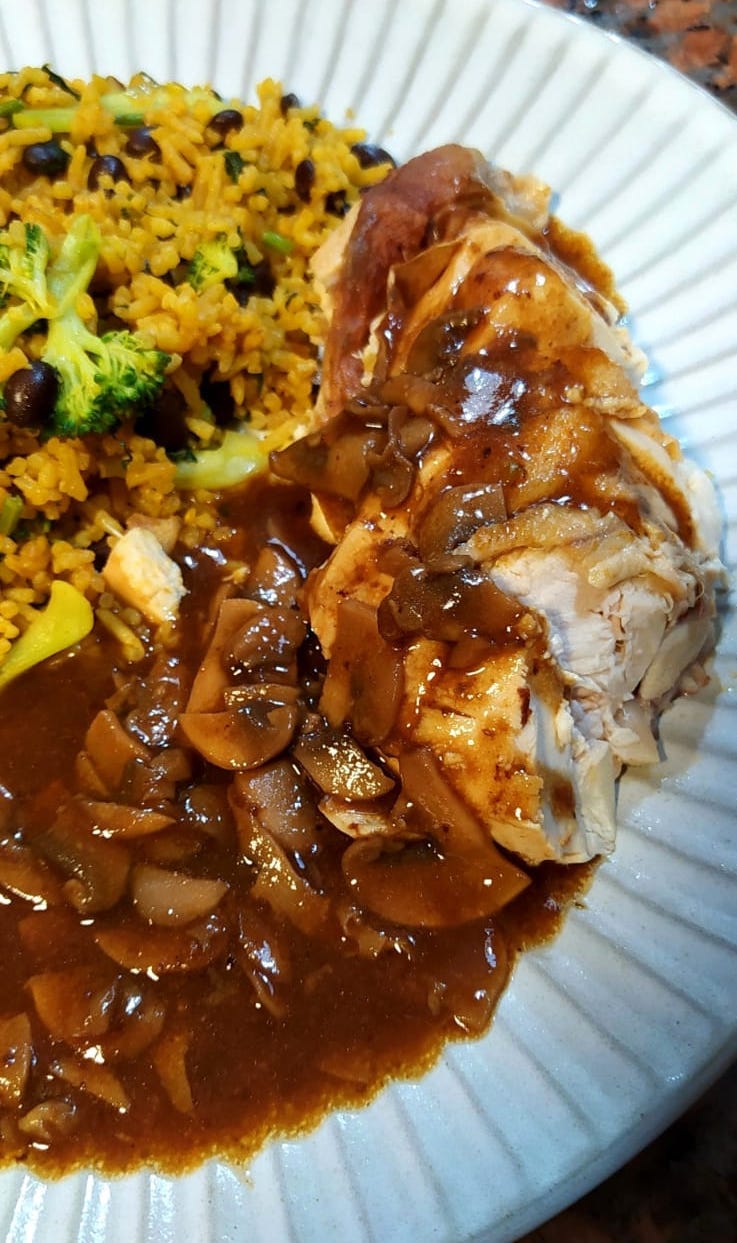In this final newsletter of the year, I’ve invited Denise Fletcher, author of How to Cook Everything Singaporean, to share a Christmas recipe that’s close to her heart. But before we get onto that, I’d like to say thank you for being a reader. It’s been fun delving into the intricacies of some of the most iconic & beloved dishes in Singapore - kueh salat, chicken rice, harjeonggai, abacus seeds, ngoh hiong, kaya, and pandan chiffon cake, just to name a few. We had guest-written newsletters, such as Yeo Min’s heong piah, Hairil Sukaime’s tempeh, Mun Yi’s wheat gluten, Nurdiana Zulkepli’s salted egg-stuffed squid and TW Lim’s lou arh. My second cookbook Plantasia also came into the world in October this year. I’m excited for what’s coming up next year, and I want to thank you for your continued support and enthusiasm! Merry Christmas and happy new year in advance 🩷🎄- Pamelia
Our Christmas, Past & Present
By Denise Fletcher
I can't remember the last time I had roast chicken at Christmas. It must have been during my twenties.
Since I moved out of my parental home and started my own family, it was first my husband's tastebuds and aspirations that shaped my Christmas dinner table offerings, then my children's as well, as my family grew. With our increasing financial ease, our Christmas spreads began inching away from the now humble Christmas roast chicken I grew up with, to the yuletide feasts glamourised in Christmas movies, print media and even supermarket ads that aimed to make us spend more, on seasonal luxuries like turkey, goose and cuts of beef sirloin, ribeye and fillet. Don't forget seasonal embellishments like morels, chestnuts, truffles, foie gras, smoked ham and salmon, gourmet sausages, scotch or brandy! It's worked so well that an offering of roast chicken for Christmas today, may draw raised eyebrows and mild derision for being such a modest offering in a season of luxury, extravagance and even, excess.
Even in a world still recovering from the ravages of Covid, massive shutdowns, job losses, invasions and war, there is every indication that people will still go all out and spend more than a pretty penny for Christmas, tomorrow be damned.
It was a very different story two generations before. My mother had been born into a struggling family of four in 1939, the year World War Two broke out. By the time she was four, her father had succumbed to tuberculosis brought on by wartime hardships, and died. He was 30. His death left my mother, her two brothers and my widowed grandmother financially in tatters. Losing the sole breadwinner meant they could no longer afford the rent for their 1-bedroom hut and were quickly evicted.
My grandmother moved in with rich relatives and earned their keep by becoming the resident housemaid and cook. Life continued to be a struggle as their presence in the rich household was barely tolerated. They were viewed with undisguised contempt and after years of insults and demeaning treatment, my grandmother eventually left with her brood. They moved from one temporary abode to another, trying to keep body and soul together. They got by as much on back-breaking but low-paying work like scrubbing floors, hauling firewood, sorting and grading ikan bilis (dried anchovies) and hae bee (dried shrimp), and cooking for weddings, as they did on the charity of kinder souls.
At one point they were living in a converted cowshed; the wide gaps between the wall boards let in rain, cow urine and small snakes that eagerly slithered in through them. They felt blessed if they had a full meal of rice and vegetables, at least once a day, and lucky if they ate twice in the same day. Often, they had to choose either to use their ration of kerosene to fuel the kerosene lamp for light, or the kerosene stove for cooking; they spent many nights in near darkness. Water was collected from a pump, which sometimes ran dry, so they collected rain to supplement their water needs.
For years, Christmas dinner would be a bowl of hot rice each, with porku teem, a garlic- and cinnamon-scented black bean and pig trotter soup and a dollop of sambal belacan, with everyone getting a piece of trotter to call their own, only because it was Christmas. This glorious, piping hot and freshly cooked feast was always gifted by a kindly aunt who struggled with her husband to feed seven children of their own.
Tragedy struck again when my mother's oldest brother was fatally hit by a British military truck at the age of 15. Young as he was, he had become the other breadwinner along with my grandmother, but despite this heartbreaking fact, the downtrodden family received no compensation whatsoever, with the military refusing to take any responsibility for the accident, so they struggled.
In time, my mother grew up, left school, started working, and life began to improve. She made every effort to give my grandmother all the things poverty had deprived her of, including medical care, utilities, new clothes, a secure and comfortable roof over her head and the best food she could afford on her very modest salary. My grandmother and mother were both brilliantly talented in the kitchen, but for years, poverty had stripped them of the opportunity to practice and refine their craft, except occasionally, for paying customers. Still, they cradled their kitchen knowledge and wisdom like the only treasure they possessed, in their hearts and minds.
Though they still had to be financially cautious, with her newfound financial independence and security, my mother began to cook up a storm in her own spartan kitchen with two small kerosene stoves, a step up from the single burner the entire family used to depend on. She was eager to show my grandmother all the lessons she had learnt while helping her to cook and bake for their rich relatives, and new things she had picked up from the yellowed second-hand magazines and cookbooks she had been painstakingly collecting.
Daily meals were still simple affairs like rice, a vegetable soup or stir-fry, and fried fish, tofu or onion omelette, always with sambal belacan on the side. After scrimping for almost a year, she finally bought an Ovenette, a portable circular electric oven, to practice baking and roasting with.
At Christmas, a fiery-red curry devil (curry debal) made with chicken chunks, sausages, smoky bacon bones and vegetables would take pride of place, surrounded by feng (a mild korma-like spiced melange of diced mixed pork offal and streaky meat), pot roasted beef knuckle (an economical cut) smothered in an onion, black pepper and dark soy sauce gravy, porku teem, a zesty and vibrant turmeric and vinegar based vegetable acar (mixed pickle), a golden, buttery sugee cake and fragrant, crumbly pineapple tarts. These were the dishes she had learnt from my grandmother. Soon, the dishes she had taught herself through cookbooks, like roast chicken with gravy, chicken pie with shortcrust pastry, fruitcake and sherry trifle, appeared alongside the dishes my grandmother had taught her.
Her roast chicken was her pride and joy and the dish that most delighted those lucky enough to eat at her table. At that time, unless one was wealthy, the norm would be to cut up a bird into as many pieces as possible before cooking, to stretch it into a meal that would feed as many as possible. Hence curries, braises and stews were very popular when many guests were expected.
To present a whole cooked bird at the table, was a treat reserved for special occasions and honoured guests. Being able to do so was a point of pride. These guests would keep reminding her all year long, to include it in her Christmas menu. She would count her pennies throughout the year, to be sure she could always provide an unforgettable Christmas feast including not one, but two whole roasted chickens!
It was a long journey from her maiden roast chicken seasoned with salt, pepper, cinnamon and butter, dotted with experiments involving a parade of bottled herbs and spices, and gimmicky "shake n bake" bags (the height of 1970s culinary innovation 😆), to her eventual triumph of Roast Chicken with Mushroom Gravy, the recipe I am sharing with you today. As a child, I wanted to dive into and wallow in her wondrous mushroom gravy. She used canned mushrooms back then, as fresh mushrooms were practically unheard of at the time, and when sighted, cost a small fortune.
Still, so transportingly good was her gravy that it is the reason I love mushrooms as much as I do, today; it is the thing that flipped the food obsession switch in my head and sparked my dive into culinary school, professional cooking and food writing. Be careful. This is very good roast chicken, but that is one life-changing gravy.
This year, as my aged mother valiantly battles dementia which has left her unable to cook, her roast chicken and gravy will take pride of place on my Christmas table. It is not grand or luxurious like roast ribeye, stuffed turkey, roast goose or beef wellington, but has earned its place as an emblem of her extraordinary strength and determination, her talent and skill in the kitchen and her triumph over poverty and adversity. My mother has taught me everything she knows. I hope to keep her legacy alive by passing on her knowledge and wisdom. From the both of us, Merry and Blessed Christmas!
Mum's Christmas Roast Chicken with Mushroom Gravy
Cook: 1 hr 15 mins Serves: 6-8





